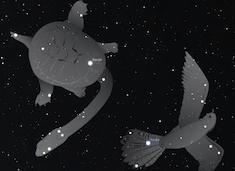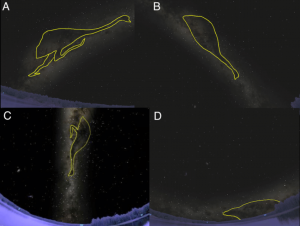Animals in the Skyworld

In Aboriginal traditions across Australia, the skyworld has topography similar to and every bit as real as the terrestrial landscape below. This realm is inhabited by plants, animals, and ancestral beings, each represented by celestial bodies, or other prominent features of the night sky, such as the prominent dark bands of the Milky Way.
William E. Stanbridge recorded some of the astronomical traditions handed to him by the Boorong clan of the Wergaia language group living near Lake Tyrell in Victoria. His papers mention several animals that relate to stars. For instance, the star Vega ( Lyrae), called Neilloan in the Wergaia language, was linked to the Mallee fowl (Leipoa ocellata), a chicken-sized ground-dwelling megapode that builds its nest-mounds when Vega rises at dusk (acronychal rising). When Vega is high in the sky at dusk (dusk meridian crossing), the birds are laying their clutches of eggs, and when Vega sets at dusk (heliacal setting), the chicks begin hatching. Similarly, the star Arcturus, called Marpeankurrk in the Wergaia language, is related to the larvae of the wood-ant, which are plentiful for only a couple of months of the year—August and September—the same time Arcturus is visible in the evening sky.
Recent studies of Aboriginal astronomical knowledge show a definitive link between animal behaviour and the positions of their celestial counterparts in the sky, particularly at dusk and dawn. Animals in the Ooldean sky of the Great Victoria Desert include the Australian Bustard (Vega), Black Cockatoo (Antares and Mars), Dingo (Achernar), Emu (Coalsack nebula), Grey Kangaroo (“Evening star”), Owlet Nightjar (Canopus), Crow (Altair), Redback Spider (Arcturus), Red Kangaroo (“Morning Star”), Thorny-devil Lizard (Pleiades), and the Wedge-tailed Eagle (Southern Cross). The positions of these stars at dusk and dawn tell the people important aspects about the animals’ behaviour, such as breeding, migration, and gestation/incubation, and rearing of the young.
 The animals in the skyward are also made up of dark spaces in the Milky Way. In Kamilaroi and Euahalayi traditions, the appearance of the celestial emu in the evening sky, traced out by the dark spaces in the Milky Way from Crux to Sagittarius, informs Aboriginal people of when emus are laying their eggs, which is an important food source. In April and May, the people see the emu as a female running as she chases a mate. In June and July, the emu becomes a male sitting on the clutch of eggs, incubating them. In August and September, the eggs begin hatching and the celestial emu is seen as a male getting up form the nest. This also tends to be when Bora initiation ceremonies were held. In October and November, the emu is seen to be sitting in waterholes, displacing water and causing some of the late-year rains in the region of northern NSW. As the celestial emu sets below the horizon in the summer months, the real emus have left the waterholes, which have since dried up.
The animals in the skyward are also made up of dark spaces in the Milky Way. In Kamilaroi and Euahalayi traditions, the appearance of the celestial emu in the evening sky, traced out by the dark spaces in the Milky Way from Crux to Sagittarius, informs Aboriginal people of when emus are laying their eggs, which is an important food source. In April and May, the people see the emu as a female running as she chases a mate. In June and July, the emu becomes a male sitting on the clutch of eggs, incubating them. In August and September, the eggs begin hatching and the celestial emu is seen as a male getting up form the nest. This also tends to be when Bora initiation ceremonies were held. In October and November, the emu is seen to be sitting in waterholes, displacing water and causing some of the late-year rains in the region of northern NSW. As the celestial emu sets below the horizon in the summer months, the real emus have left the waterholes, which have since dried up.
The dark dust lanes in the Milky Way are also home to a range of animals, including crocodiles, kangaroos, and serpents.
Published Research
- Fuller, R.S., Anderson, M.G., Norris, R.P., and Trudgett, M.M. (2014). The emu sky knowledge of the Kamilaroi and Euahlayi Peoples. Journal of Astronomical History and Heritage, Vol. 17(2), pp. 171–179.
- Leaman, T.M., Hamacher, D.W., and Carter, M. (2016). Aboriginal Astronomical traditions from Ooldea, South Australia, Part 2: Animals in the Ooldean Sky. Journal of Astronomical History and Heritage, Vol. 19(1), pp. 61-78.
- Fuller, R.S., Norris, R.P., and Trudgett, M.M. (2014). The Astronomy of the Kamilaroi and Euahlayi Peoples and Their Neighbours. Australian Aboriginal Studies, Vol. 2014(2), pp. 3-27.
- Hamacher, D.W. and Norris, R.P. (2011). “Bridging the gap” through Australian cultural astronomy. Archaeoastronomy and Ethnoastronomy: building bridges between cultures, edited by Clive Ruggles. Cambridge University Press, pp. 282-290.
- Morieson, J. (1999). The Astronomy of the Boorong. Australian Journal of Indigenous Issues, Vol. 2(4), pp. 19-28.
- Tindale, N.B. (1983). Celestial lore of some Australian Aboriginal tribes. Archaeoastronomy, Vol. 12/13, pp. 258-379.
